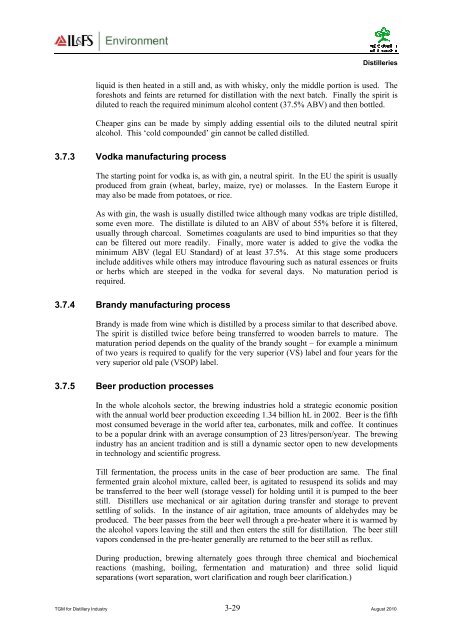Distillieries - Environmental Clearance
Distillieries - Environmental Clearance
Distillieries - Environmental Clearance
Create successful ePaper yourself
Turn your PDF publications into a flip-book with our unique Google optimized e-Paper software.
Distilleriesliquid is then heated in a still and, as with whisky, only the middle portion is used. Theforeshots and feints are returned for distillation with the next batch. Finally the spirit isdiluted to reach the required minimum alcohol content (37.5% ABV) and then bottled.Cheaper gins can be made by simply adding essential oils to the diluted neutral spiritalcohol. This ‘cold compounded’ gin cannot be called distilled.3.7.3 Vodka manufacturing processThe starting point for vodka is, as with gin, a neutral spirit. In the EU the spirit is usuallyproduced from grain (wheat, barley, maize, rye) or molasses. In the Eastern Europe itmay also be made from potatoes, or rice.As with gin, the wash is usually distilled twice although many vodkas are triple distilled,some even more. The distillate is diluted to an ABV of about 55% before it is filtered,usually through charcoal. Sometimes coagulants are used to bind impurities so that theycan be filtered out more readily. Finally, more water is added to give the vodka theminimum ABV (legal EU Standard) of at least 37.5%. At this stage some producersinclude additives while others may introduce flavouring such as natural essences or fruitsor herbs which are steeped in the vodka for several days. No maturation period isrequired.3.7.4 Brandy manufacturing processBrandy is made from wine which is distilled by a process similar to that described above.The spirit is distilled twice before being transferred to wooden barrels to mature. Thematuration period depends on the quality of the brandy sought – for example a minimumof two years is required to qualify for the very superior (VS) label and four years for thevery superior old pale (VSOP) label.3.7.5 Beer production processesIn the whole alcohols sector, the brewing industries hold a strategic economic positionwith the annual world beer production exceeding 1.34 billion hL in 2002. Beer is the fifthmost consumed beverage in the world after tea, carbonates, milk and coffee. It continuesto be a popular drink with an average consumption of 23 litres/person/year. The brewingindustry has an ancient tradition and is still a dynamic sector open to new developmentsin technology and scientific progress.Till fermentation, the process units in the case of beer production are same. The finalfermented grain alcohol mixture, called beer, is agitated to resuspend its solids and maybe transferred to the beer well (storage vessel) for holding until it is pumped to the beerstill. Distillers use mechanical or air agitation during transfer and storage to preventsettling of solids. In the instance of air agitation, trace amounts of aldehydes may beproduced. The beer passes from the beer well through a pre-heater where it is warmed bythe alcohol vapors leaving the still and then enters the still for distillation. The beer stillvapors condensed in the pre-heater generally are returned to the beer still as reflux.During production, brewing alternately goes through three chemical and biochemicalreactions (mashing, boiling, fermentation and maturation) and three solid liquidseparations (wort separation, wort clarification and rough beer clarification.)TGM for Distillery Industry 3-29 August 2010

















